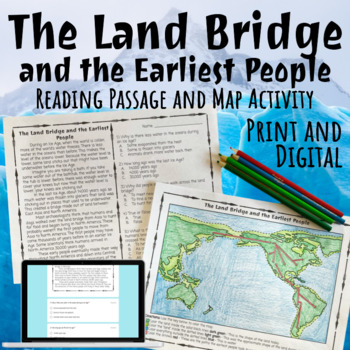The Land Bridge Beringia Reading Comprehension Passage and Map Activity
- PDF
- Google Apps™

What educators are saying
Description
In this activity, students complete a short reading passage about the Bering Land Bridge (also called Beringia) to learn how Native Americans crossed from Russia to Alaska to settle in the Americas during the last Ice Age. This lesson also includes a map coloring activity that examines how the water level in the oceans dropped during Ice Age, revealing land that formed a bridge the earliest people could walk across.
This resource includes:
- A short reading passage with 5 multiple choice comprehension questions
- An answer key for the reading passage
- A force copy link to a digital, self-scoring Google Forms version of the reading passage for virtual learning
- A map of the old vs. new shape of landmasses and paths the earliest people took with a key that tells students which colors to use to color the map
- A completed map to use as an example or answer key
- Suggested discussion questions
Please follow my store here for more great resources!
You can also find me on Facebook, Instagram, and lafountaineofknowledge.com where you'll discover ideas, inspiration, and plenty of freebies! Or join my email list to get my monthly newsletter with exclusive FREE resources you can't get anywhere else!
Want free money to spend on Teachers Pay Teachers? Rate this product to earn some TpT credit! Leaving feedback helps us both out and takes less than a minute! Your support makes it possible for me to continue making and sharing great resources! Thank you!
Credits: Cover photo by Luis Valiente sourced via Pixabay and used with permission. Spear clipart by Wrisa Waymer, sourced from Pixabay and used with permission. World map by Hidesy’s Clipart on TPT (used with permission). Fonts used include Coming Soon by Open Window and Joti One by Eduardo Tunni, used with permission under open source licenses.





